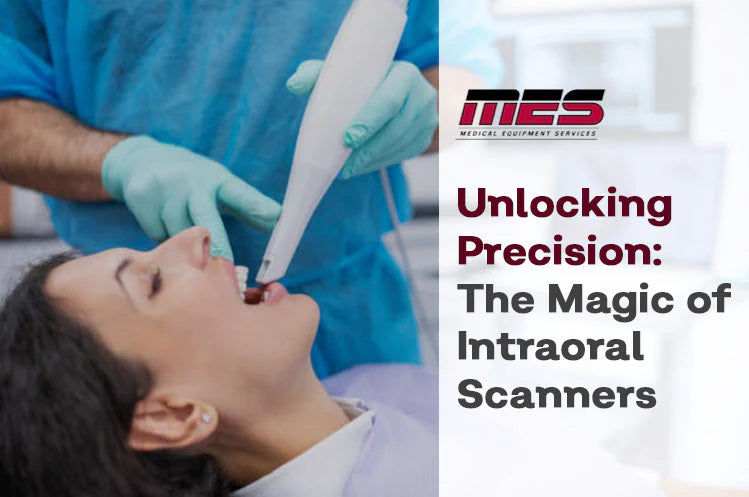In the world of dentistry, precision is paramount. Every detail matters, whether it's a cavity that needs filling or a crown that needs crafting. That's where intraoral scanners come in – these technological marvels have revolutionised the way dentists capture images of the oral cavity, allowing for greater accuracy and efficiency in diagnosis and treatment planning.
In this article, we'll delve into the magic of intraoral scanners, exploring their evolution, working principles, applications, benefits, challenges, future trends, and real-world case studies.
Evolution of Intraoral Scanners
Intraoral scanners have come a long way since their inception. Early developments in the 1980s laid the foundation for today's sophisticated devices. Initially, these scanners were bulky and had limited capabilities.
However, with advancements in technology, modern intraoral scanners have become compact, lightweight, and incredibly precise. Today, they are an essential tool in every dental practice, offering unparalleled accuracy and efficiency.
How Intraoral Scanners Work
At their core, intraoral scanners use optical scanning technology to capture detailed images of the teeth and surrounding structures. The scanner emits a light source onto the area being scanned, and a camera captures the reflected light, creating a digital impression.
This impression is then processed using specialised software to create a highly accurate 3D model of the oral cavity. The digital model can be manipulated and analysed to aid in treatment planning and communication with patients.
Applications in Dentistry
The applications of intraoral scanners in dentistry are vast and varied. One of the most common uses is in restorative dentistry, where these scanners are used to create digital impressions for crowns, bridges, and veneers.
In orthodontics, intraoral scanners are used to create digital models of the teeth, eliminating the need for messy traditional impressions. Prosthodontists also benefit from intraoral scanners, as they can use digital impressions to design and fabricate dentures and implants with unparalleled precision.
Benefits of Intraoral Scanners
One of the primary benefits of intraoral scanners is their ability to improve accuracy. Traditional impressions can be prone to distortion and inaccuracies, leading to ill-fitting restorations. Intraoral scanners eliminate this margin of error, resulting in restorations that fit perfectly the first time.
Additionally, intraoral scanners are incredibly time-efficient, reducing the time patients spend in the chair and allowing dentists to see more patients in a day. Furthermore, patients often find intraoral scanning more comfortable than traditional impressions, as there is no need for bulky trays or messy materials.
Comparison with Traditional Methods
When comparing intraoral scanners to traditional impression methods, the advantages are clear. In addition to improved accuracy and patient comfort, intraoral scanners are also cost-effective in the long run.
While the initial cost of purchasing an intraoral scanner may be higher than traditional materials, the savings in material costs and time make them a worthwhile investment for many dental practices.
Challenges and Limitations
Despite their many benefits, intraoral scanners are not without their challenges. One of the main challenges is the learning curve associated with using these devices. Dentists and dental assistants must undergo training to learn how to use the scanners effectively.
Additionally, the cost of purchasing and maintaining an intraoral scanner can be prohibitive for some dental practices, especially smaller ones. However, the benefits of intraoral scanners often outweigh these challenges, making them a valuable addition to any dental practice.
Future Trends
Looking ahead, the future of intraoral scanners is bright. As technology continues to advance, we can expect to see even more integration with CAD/CAM technology, allowing for the seamless design and fabrication of restorations in a single visit.
Furthermore, advancements in scanning technology may lead to even greater accuracy and efficiency in the years to come. Overall, the future of intraoral scanners looks promising, with continued advancements that will further improve patient care and treatment outcomes.
Case Studies
Real-world examples of intraoral scanners in action highlight their effectiveness and impact on patient care. Case studies demonstrating the use of intraoral scanners in various dental procedures can provide valuable insights into their practical applications and benefits.
These case studies can also help dental professionals understand how to integrate intraoral scanners into their practice and maximise their benefits.
Conclusion
In conclusion, intraoral scanners have revolutionised the field of dentistry, providing dentists with a powerful tool for improving accuracy, efficiency, and patient comfort. As technology continues to advance, we can expect to see even greater integration of intraoral scanners into dental practices, further enhancing the quality of care provided to patients.
With their numerous benefits and wide range of applications, intraoral scanners are a valuable investment for any dental practice looking to enhance its diagnostic and treatment capabilities.
At MES Australia, we understand the significance of providing state-of-the-art dental equipment that meets the evolving needs of dental practices. With over 60 years of experience, we take pride in being a trusted supplier of high-quality dental chairs and equipment in Australia.
For all your medical and dental supply requirements, please call us today on 1300 342 013 or leave an enquiry.


